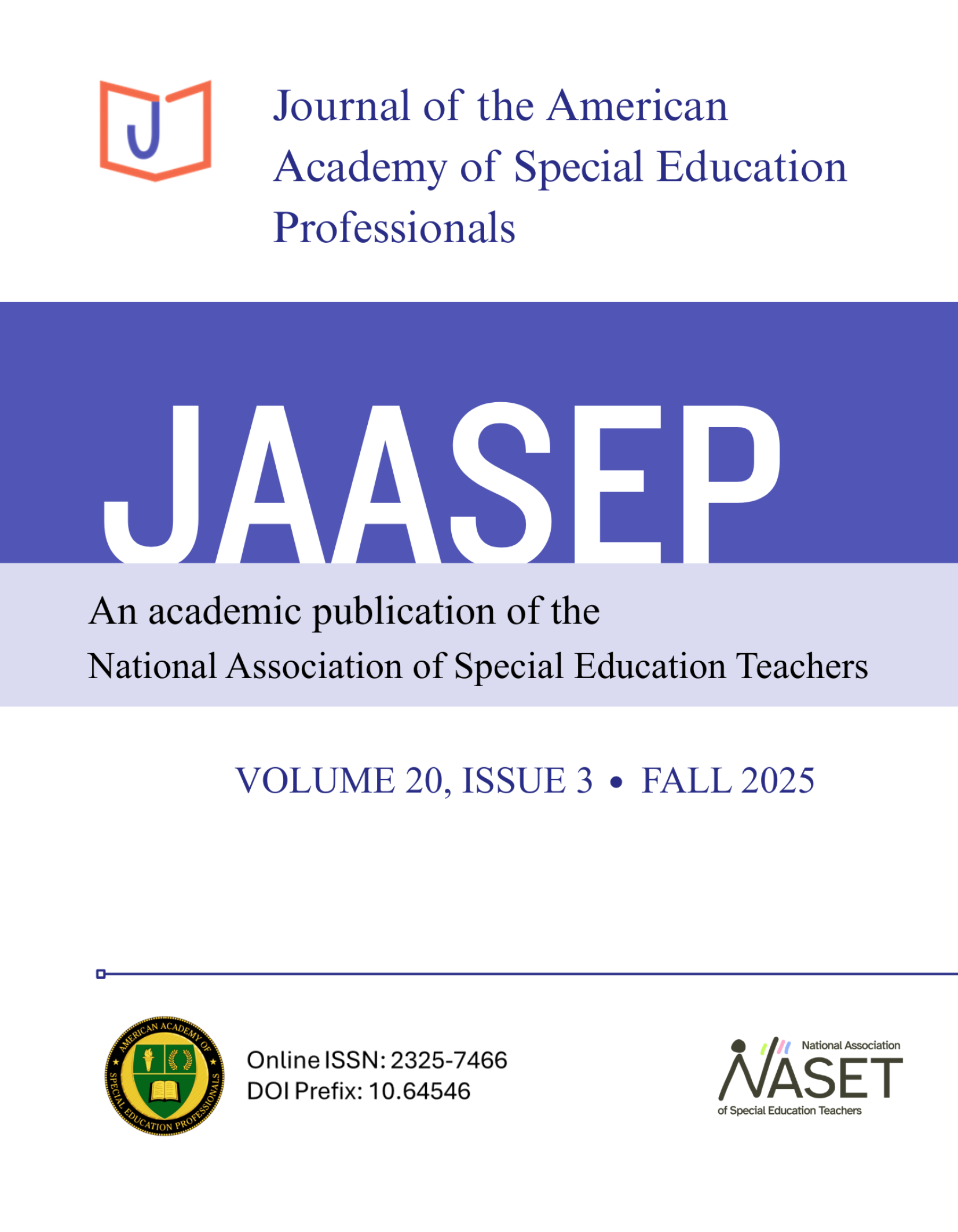Effectiveness of a peer-mediated intervention on writing skills for students with autism
American Psychiatric Association. (2013). Autism spectrum disorder. In Diagnostic and statistical manual of mental disorders (5th ed.). DOI: https://doi.org/10.1176/appi.books.9780890425596
Haas, A., Vannest, K., Thompson, J., Fuller, M., & Wattanawongwan, S. (2020). Peer mediated instruction and academic outcomes for students with Autism Spectrum Disorders: A comparison of quality indicators. Mentoring and Tutoring: Partnership in Learning, 25(5), 625–642. DOI: 10.1080/13611267.2020.1859330 DOI: https://doi.org/10.1080/13611267.2020.1859330
Asaro-Saddler, K., & Bak, N. (2014). Persuasive writing and self-regulation training for writers with autism spectrum disorders. The Journal of Special Education, 48(2), 92–105. https://doi.org/10.1177/0022466912474101 DOI: https://doi.org/10.1177/0022466912474101
Ayvazo, S., & Aljadeff‐Abergel, E. (2014). Classwide peer tutoring for elementary and high school students at risk: Listening to students’ voices. Support for Learning, 29(1), 76–92. https://doi.org/10.1111/1467-9604.12047 DOI: https://doi.org/10.1111/1467-9604.12047
Bicakci, M., & Olçay, S. (2019). Effect of Peer Delivered Social Stories on the Crossing Skills of Primary School Students with Developmental Disabilities. Eğitim ve Bilim, 44, 257–278. https://doi.org/10.15390/EB.2019.8168 DOI: https://doi.org/10.15390/EB.2019.8168
Bowman-Perrott, L., Davis, H., Vannest, K., Williams, L., Greenwood, C., & Parker, R. (2013). Academic benefits of peer tutoring: A meta-analytic review of single-case research. School Psychology Review, 42(1), 39–55. https://doi.org/10.1080/02796015.2013.12087490 DOI: https://doi.org/10.1080/02796015.2013.12087490
Carter, E. W., Cushing, L. S., Clark, N. M., & Kennedy, C. H. (2005). Effects of peer support interventions on students' access to the general curriculum and social interactions. Research and Practice for Persons With Severe Disabilities, 30(1), 15–25. https://doi.org/10.2511/rpsd.30.1.15 DOI: https://doi.org/10.2511/rpsd.30.1.15
Carter, E. W., Moss, C. K., Asmus, J., Fesperman, E., Cooney, M., Brock, M. E., Lyons, G., Huber, H. B., & Vincent, L. B. (2015). Promoting inclusion, social connections, and learning through peer support arrangements. TEACHING Exceptional Children, 48(1), 9–18. https://doi.org/10.1177/0040059915594784 DOI: https://doi.org/10.1177/0040059915594784
Carter, E. W., Moss, C. K., Hoffman, A., Chung, Y. C., & Sisco, L. (2011). Efficacy and social validity of peer support arrangements for adolescents with disabilities. Exceptional Children, 78(1), 107–125. https://doi.org/10.1177/001440291107800107 DOI: https://doi.org/10.1177/001440291107800107
Chang, Y. C., & Locke, J. (2016). A systematic review of peer-mediated interventions for children with autism spectrum disorder. Research in autism spectrum disorders, 27, 1–10. https://doi.org/10.1016/j.rasd.2016.03.010 DOI: https://doi.org/10.1016/j.rasd.2016.03.010
Essig, L., Rotta, K., & Poling, A. (2023). Interobserver agreement and procedural fidelity: An odd asymmetry. Journal of applied behavior analysis, 56(1), 78–85. https://doi.org/10.1002/jaba.961 DOI: https://doi.org/10.1002/jaba.961
Fetko, E. E., Collins, B. C., Hager, K. D., & Spriggs, A. D. (2013). Embedding science facts in leisure skill instruction conducted by peer tutors. Education and Training in Autism and Developmental Disabilities, 400-411. DOI: https://doi.org/10.1177/215416471304800310
Finlay, C., Kinsella, W., and Prendeville, P. (2022). The professional development needs of primary teachers in special classes for children with autism in the republic of Ireland. Prof. Dev. Educ. 48, 233–253. doi: 10.1080/19415257. 2019.1696872 DOI: https://doi.org/10.1080/19415257.2019.1696872
Hart, S. L., & Banda, D. R. (2018). Examining the effects of peer mediation on the social skills of students with autism spectrum disorder as compared to their peers. Education and Training in Autism and Developmental Disabilities, 53(2), 160–175. https://eric.ed.gov/?id=EJ1179174 DOI: https://doi.org/10.1177/215416471805300205
Heron, T. E., Villareal, D. M., Yao, M., Christianson, R. J., & Heron, K. M. (2006). Peer tutoring systems: Applications in classroom and specialized environments. Reading & Writing Quarterly, 22(1), 27–45. https://doi.org/10.1080/10573560500203517 DOI: https://doi.org/10.1080/10573560500203517
Hodges, H., Fealko, C., and Soares, N. (2020). Autism spectrum disorder: Definition, epidemiology, causes, and clinical evaluation. Transl. Pediatr. 9, S55– S65. doi: 10.21037/tp.2019.09.09 DOI: https://doi.org/10.21037/tp.2019.09.09
Jameson, J. M., McDonnell, J., Polychronis, S., & Riesen, T. (2008). Embedded, constant time delay instruction by peers without disabilities in general education classrooms. Intellectual and Developmental Disabilities, 46(5), 346–363. https://doi.org/10.1352/2008.46:346-363 DOI: https://doi.org/10.1352/2008.46:346-363
Kalambouka, A., Farrell, P., Dyson, A., & Kaplan, I. (2017). The impact of placing pupils with special education needs in mainstream schools on the achievement of their peers. Educational Research, 49(4), 365–382. https://doi.org/10.1080/00131880701717222 DOI: https://doi.org/10.1080/00131880701717222
Leach, D., & Helf, S. (2016). Revisiting the regular education initiative: Multi-tiered systems of support can strengthen the connection between general and special education. Journal of the American Academy of Special Education Professionals, 116-124. https://eric.ed.gov/?id=EJ1129699 DOI: https://doi.org/10.64546/jaasep.321
Matthews, N. L., Orr, B. C., Warriner, K., DeCarlo, M., Sorensen, M., Laflin, J., & Smith, C. J. (2018). Exploring the effectiveness of a peer-mediated model of the PEERS curriculum: A pilot randomized control trial. Journal of Autism and Developmental Disorders, 48(7), 2458–2475. https://doi.org/10.1007/s10803-018-3504-2 DOI: https://doi.org/10.1007/s10803-018-3504-2
McCurdy, E. E., & Cole, C. L. (2014). Use of a peer support intervention for promoting academic engagement of students with autism in general education settings. Journal of Autism and Developmental Disorders, 44(4), 883–893. https://doi.org/10.1007/s10803-013-1941-5 DOI: https://doi.org/10.1007/s10803-013-1941-5
Morris, S., O’Reilly, G., & Nayyar, J. (2021). Classroom-based peer interventions targeting autism ignorance, prejudice and/or discrimination: A systematic PRISMA review. International Journal of Inclusive Education. https://doi.org/10.1080/13603116.2021.1900421 DOI: https://doi.org/10.1080/13603116.2021.1900421
Odluyurt, S., Tekin Iftar, E., & Ersoy, G. (2014). Effects of School Counselor Supervised Peer Tutoring in Inclusive Settings on Meeting IEP Outcomes of Students with Developmental Disabilities. Education and Training in Autism and Developmental Disabilitites, 49, 415–428. DOI: https://doi.org/10.1177/215416471404900307
Richards, S. B., Taylor, R. L., & Ramasamy, R. (2014). Single subject research: Applications in educational and clinical settings (2nd ed.). Belmont, CA: Wadsworth, Cengage Learning.
Saddler, B., Behforooz, B., & Asaro, K. (2008). The effects of sentence-combining instruction on the writing of fourth-grade students with writing difficulties. The Journal of Special Education, 42(2), 79–90. https://doi.org/10.1177/0022466907310371 DOI: https://doi.org/10.1177/0022466907310371
Skar, G. B., Graham, S., & Huebner, A. R. (2023). Efficacy for writing self-regulation, attitude toward writing, and quality of second grade students' writing. Frontiers in psychology, 14, 1265785. https://doi.org/10.3389/fpsyg.2023.1265785 DOI: https://doi.org/10.3389/fpsyg.2023.1265785
Vukelich, C., Justice, L. M., & Han, M. (2013). Impact of supplemental tutoring configurations for preschoolers at risk for reading difficulties. Child & Youth Care Forum, 42(1), 19–34). https://doi.org/10.1007/s10566-012-9184-8 DOI: https://doi.org/10.1007/s10566-012-9184-8
Vygotsky, L. S. (1978). Mind in society: The development of higher psychological processes. Harvard University Press.
Whitby, P. J. S., Travers, J. C., & Harnik, J. (2009). Academic achievement and strategy instruction to support the learning of children with high-functioning autism. Beyond Behavior, 19(1), 3–9.
